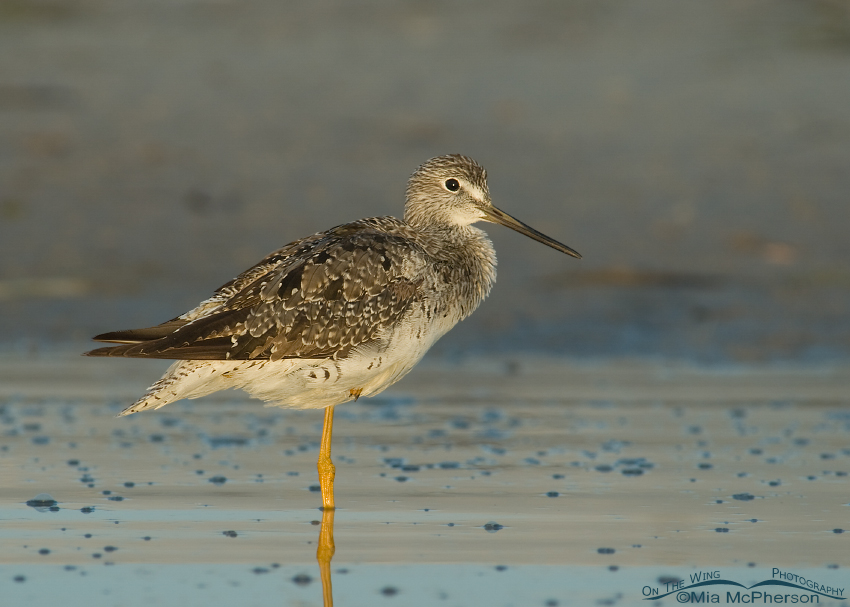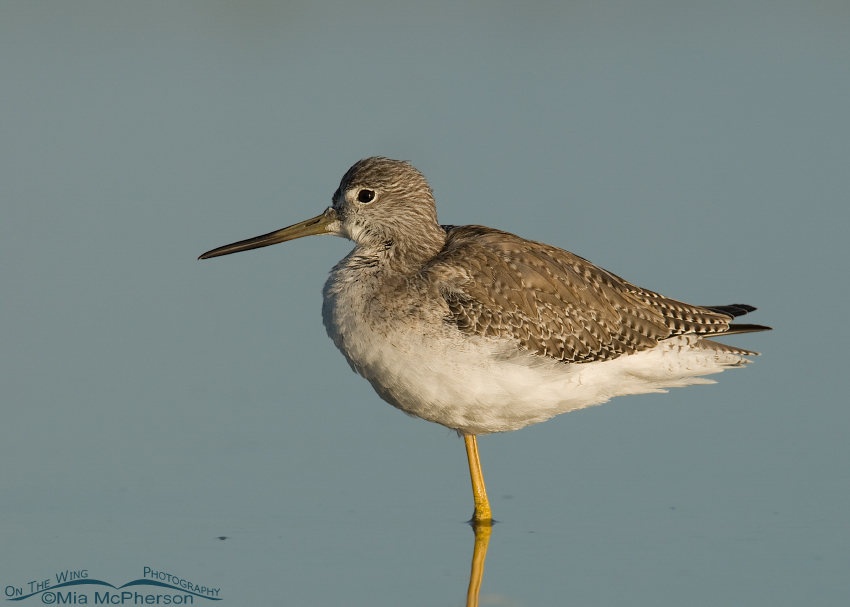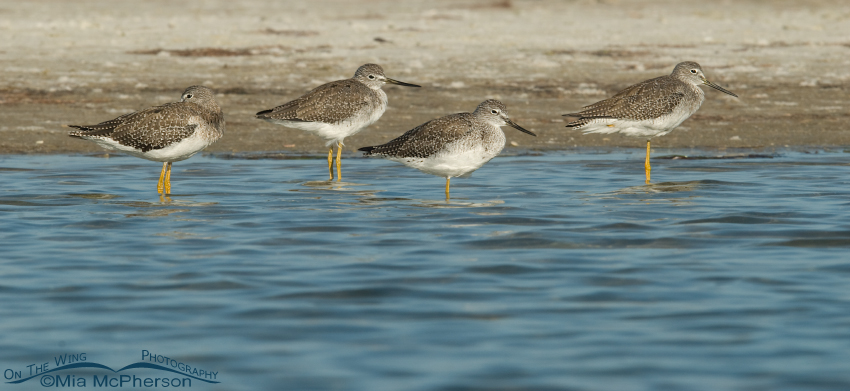 Resting Greater Yellowlegs (Tringa melanolueca) – Nikon D200, handheld, f6.3, 1/160, ISO 200, Nikkor 80-400mm VR at 400mm, natural light
Resting Greater Yellowlegs (Tringa melanolueca) – Nikon D200, handheld, f6.3, 1/160, ISO 200, Nikkor 80-400mm VR at 400mm, natural light
Obtaining a low angle with small shorebirds can bring the viewer into the bird’s world by being down to their level. When I photographed shorebirds in Florida I was either constantly covered in sand or mud, wet or all three. I looked a mess but I really didn’t mind sand-crawling through mud and sand, sitting or laying down in the water to get the low perspective I desired. Sometimes it actually helped to cool me off when the heat was on.
I photographed this Greater Yellowlegs by sitting very low in a lagoon then bending down to get the bottom of my lens just above the surface of the water. The rising sun gave the bird a nice glow and the eye contact plus the head turn worked very well. I also liked the bubbles on the surface of the water.
 Greater Yellowlegs (Tringa melanolueca) in a quiet lagoon – Nikon D200, handheld, f7.1, 1/750, ISO 160, Nikkor 80-400mm VR at 300mm, natural light
Greater Yellowlegs (Tringa melanolueca) in a quiet lagoon – Nikon D200, handheld, f7.1, 1/750, ISO 160, Nikkor 80-400mm VR at 300mm, natural light
This image was taken in the evening, the bird was in the lagoon and I laid flat on my belly at the edge of the water to get this low angle shot with part of my upper torso in the shallows. How nice that the shorebirds will often look in the direction of the sunlight as there are some bird & animal species that don’t seem to enjoy the sun directly in their eyes, Coyotes and several owl species come to mind.
 Greater Yellowlegs (Tringa melanolueca) – Nikon D200, handheld, f14, ISO 250, 1/250, Nikkor 80-400mm VR at 210mm, natural light
Greater Yellowlegs (Tringa melanolueca) – Nikon D200, handheld, f14, ISO 250, 1/250, Nikkor 80-400mm VR at 210mm, natural light
I photographed this group of Greater Yellowlegs by kneeling in the water, bending forward and placing my elbows on the lagoon bottom to brace my arms and use them to steady my camera and lens. I used f14 for my aperture to try to get enough depth of field to get all the birds sharp and that dropped my shutter speed to 1/250, I could have bumped up my ISO to get more shutter speed but I felt that I was steady enough to get a sharp image even though the shutter speed was slow.
Life is good.
Mia
Click here to see more of my Greater Yellowlegs photos plus facts and information about this species.


Sweet light on these birds. Maybe I will get to do some beach crawling myself in about 6 weeks! What kind of shoes did you wear?
Julie, I wear Merrell water shoes when I sand crawl and take images from in the water. They give a good grip on wet surfaces, tie tight at the top and they have mesh areas to allow the water to drain out while keeping things like sharp pieces of shells out. Some sand does still get inside but that can be swished out. I believe I ordered mine on line. Thanks for your comment!
btw: meant to say, I’ve never been as immersed as you were for this shot. You definitely serve as inspiration.
Thank you Ingrid!
Lovely images Mia, and I really appreciate you sharing your camera settings and know-how. Now if only the waters weren’t icy cold up here, I might try your immersion technique!
Mel, the water would be too cold up there but I’ve heard of people putting on waders to get shots like these as far north as Alaska. Thanks very much for commenting on these images.
Oops! “Yellowlegs”
I’m grinning with you Bob, I make typos on your blog too!
Down here it can be dangerous getting in the water for such photos. Water mocassins and cotton-mouths can be life threatening. Even laying on the ground there are the fireants, rattlesnakes, and scorpions. Definitely, care must be taken. I salute you for what you go through to get the right image.
Great images of the Greater Yellowlages.
Bob, I only ever went into salt water in Florida because of the gators and the snakes that are in fresh water. I had to always look before I laid down for ants and sharp objects. In the water I had to look out for little Rays. The shrimp, pipefish and crabs didn’t bother me much though. Thanks for your wonderful comment!
Mia, I agree with Scott … you did go the extra mile, and the outcome is stunning. I’m particularly fond of the last one. The precision and symmetry is so pretty. There’s just something about those yellow legs. I was trying to think of the last time I was in an area with birds where I could get down in the mud and sand. A lot of the Seattle shoreline is privately held and there aren’t too many access points, and definitely not many shorebirds. I guess that needs to be my goal for 2012 — to get back in the mud and back on the ocean.
Thank you Ingrid, your comments mean a lot to me. I agree, there is just something about those yellow legs. I haven’t gotten down in the mud and sand much since moving to Utah but if I am nrea the water’s edge and a bird comes along you can bet I’ll flop right down! I hope that you get back to the mud and the ocean. Maybe only bird photographers understand that!
Beautiful shots, Mia. You went the extra mile for these ones!
Thank you Scott, your comment is very kind!
beautiful images! the clarity is amazing I enjoyed looking
I enjoyed looking
Hi Rachel, thanks for stopping by my site and for commenting.
Beautiful images! I really like the stillness in the second photo!
Tammy, I like the stillness of the second photo too, it just feels peaceful. Thanks for your wonderful comment.
Wow! I too am in awe of your photography! Just beautiful and you’re awesome to get in the water like that!
Thanks Judy, we have such incredible subjects.
Mia, I continue to be in awe of your bird photography. That first yellowlegs photo may be the best shorebird photo I’ve ever seen.
Thank you Bill, you are going to make me blush!
You’re so right. IT seems kinda risky at times, especially with really nice equipment, but these are outstanding shots.
Laurence, I know of another female photographer who has dunked her gear twice in the past year, I’m very happy that I have never done that. I’m always very careful around water, even where I put my feet so I don’t slip. Thanks for your kind comment.
Really nice. Well worth all the effort. Thanks.
Gene
Thanks Gene, I’m glad that you enjoyed these images.